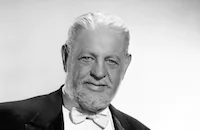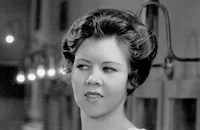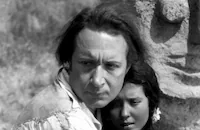The Great Man's Lady
Brief Synopsis
Cast & Crew
William A. Wellman
Barbara Stanwyck
Joel Mccrea
Brian Donlevy
Katherine Stevens
Thurston Hall
Film Details
Technical Specs

Synopsis
In Hoyt City, the dedication of a statue commemorating the city's founder, Ethan Hoyt, prompts reporters to converge on the home of one-hundred-year-old Hannah Sempler to urge her finally to reveal the secret of her association with Ethan. Hannah resents the scandal-mongers and sends them away, but softens her stance when a young biographer starts to leave in tears because, without information from Hannah, her biography of Ethan will be incomplete. Hannah recalls her past: In 1848, in Philadelphia, Hannah is smitten by young Ethan when he visits her father and asks him to invest in his plans for a city in an unpopulated area of the West. The shortsighted Sempler refuses, and although the spirited Hannah is engaged to stuffy Cadwallader, she runs away with Ethan and marries him on the trail to his Western property. Hannah adapts well to the difficult life of a homesteader and shares Ethan's dream of building a great city. When he gets drunk and loses their savings and property to gambler Steely Edwards, Hannah confronts Steely, a charmer who immediately falls in love with her, and wins everything back. Steely follows Hannah and Ethan for eight years as they move to California in search of gold. Hannah finally settles in Sacramento and runs a boarding house while Ethan continues to prospect. Ethan grows jealous of Steely, who is always with Hannah, although their relationship has remained platonic. One night Ethan returns from Virginia City feeling defeated because all he has found is some "blue stuff." Hannah tests deposits left on his boots and learns that they are silver. She borrows money from Steely so that Ethan can return to Virginia City and buy up the mines, but will not go with Ethan because she is pregnant. Hannah refuses to divulge her reason for not leaving for fear her pregnancy will keep Ethan from his dream, and Ethan, wrongly suspecting an affair between her and Steely, leaves her for good. Steely helps support Hannah, but when floods threaten Sacramento, he buys her and her twin babies a seat on a wagon headed for Virginia City, because he knows in his heart that Ethan will always come first for her. The wagon is washed off a bridge by a flash flood, and although Hannah survives, she loses the babies. Steely assumes that she has been killed and goes to Virginia City to give Ethan the news. Ethan, now rich, shoots Steely. Only wounded, Steely recovers and returns to Sacramento, where he finds Hannah, much changed because of the loss of her children. Hannah learns that Ethan has remarried and returned to Hoyt City, and decides to allow him to continue to assume that she is dead. By 1868, Hannah and Steely are operating a fashionable casino in San Francisco. Hannah leaves, however, after her father visits and is only concerned about the potential trouble her marriage may cause Ethan's campaign for Senator if anyone should discover she is alive. Hannah returns to Hoyt City and meets with the now corrupted Ethan, explaining what truly happened during the flood. Her visit rekindles the idealism that he has lost, and while she remains alone in their first home, Ethan realizes his dream of Hoyt City and goes on to become a great senator and civic leader. Hannah does not see Ethan again until 1906, when Ethan, who privately credits her with his achievements, returns home to die. His death coincides with Steely's death in the great San Francisco fire. Hannah's home on the original site of their cabin is now in the midst of a city, and she and the young biographer walk to the statue. The biographer, moved by the real story of how Hannah helped to make Ethan great, resolves to discard her biography so that she can fulfill her own destiny. Alone by the statue, Hannah rips up her tattered marriage certificate to ensure that no one will ever be able to taint the honorable memory of Ethan Hoyt.

Director

William A. Wellman
Cast

Barbara Stanwyck

Joel Mccrea

Brian Donlevy
Katherine Stevens

Thurston Hall
Lloyd Corrigan
Etta Mcdaniel
Frank M. Thomas

William B. Davidson
Lillian Yarbo
Helen Lynd

Mary Treen

Lucien Littlefield

John Hamilton
"snowflake" Fred Toones
Damian O'flynn

Charles Lane
George Chandler
Milton Parsons
Anna Q. Nilsson
George P. Huntley

George Irving

Fern Emmett
David Clyde
Eleanor Stewart
Ottola Nesmith
Pat O'malley

Irving Bacon
Hank Bell

Monte Blue
Larry Lawson

Lee Phelps
Theodor Von Eltz
Lee Moore
Buck Mack
Charles Williams
Bob Perry
Crew
Teet Carle
Herb Coleman
B. G. Desylva
Hans Dreier
Don English
Jack Golconda
Bert Granger
Edith Head
Earl Hedrick
Gordon Jennings
Clem Jones
Joe Keller
William C. Mellor
Harry Mills
Walter Oberst
Seena Owen
Clements Ripley
Les River
W. L. River
Roy Roberts
Thomas Scott
Adela Rogers St. Johns
Sydney S. Street
Darrell Turnmire
Waldo Twitchell
William A. Wellman
William A. Wellman
Wally Westmore
Victor Young
Joseph C. Youngerman
George Ziegler

Videos
Movie Clip


Film Details
Technical Specs

Articles
The Great Man's Lady
Tall, broad-shouldered, handsome in an open-faced way, McCrea projected an unforced masculinity that sat well in several genres and made him a sought-after leading man. He made six films with Barbara Stanwyck, starting with Gambling Lady (1934). Stanwyck was even more versatile - equally adept in screwball comedy, drama, noir, and Westerns - 21 of the latter. Their last collaboration was William Wellman's The Great Man's Lady (1942), with Stanwyck's 100-plus year old pioneer woman, Hannah Sempler, framing the story of how McCrea's idealistic cowboy, Ethan Hoyt, persevered until he called a large metropolis into being and died, revered as his state's Senator, with her role in his life veiled in mystery. (Speaking of versatility for the last time here, let it be noted that The Great Man's Lady was sandwiched between two Preston Sturges comedies in which McCrea starred - 1941's Sullivan's Travels and 1942's The Palm Beach Story.)
The Great Man's Lady was called into being after Cecil B. DeMille's Western epic, Union Pacific (1939), hit big co-starring McCrea and Stanwyck. They were reunited with that film's heavy, Brian Donlevy, who this time also plays a rogue, but a nice one, with heart. The story, spanning almost a century, begins with McCrea, in fringed buckskin and Stetson hat, riding up to Philadelphia society girl Stanwyck's imposing residence to ask her father for backing. (He's turned down.) A few flirty glances later, and he's off with her on horseback to his largely unsettled corner of the West, where his wooden shack is pretty much the only structure in the city he dreams of building there. The basis of their partnership is simple. He provides the vision, she provides the spine. When he's on the verge of selling his acreage to a railroad for a pittance, she intervenes and routs the interloper, all the while pretending she's a homespun cowgirl.
When Ethan seeks to increase his stake by gambling with Donlevy's barnstorming card sharp, Steely Edwards, and slinks home without a cent or a piece of livestock to his name, she's the one who tracks the gambler down and retrieves their assets at gunpoint. So it goes, until word of the California gold rush reaches them, and they head to Sacramento, where she slaves away, running a boarding house for eight years while he amasses stake after stake to embark upon futile search after futile search for the yellow metal. One night when he returns home once more empty handed and collapses on their bed, she notices a particular complexion to the muck on his boots. Silver! Off he gallops, back to Virginia City, to start laying claim to mine after mine. She stays behind, not having told him she's pregnant, and resisting the advances of Donlevy's gambler, who remains just this side of gentlemanly.
Enter a flood, taking out Sacramento, resulting in the death of her twin babies. Donlevy, who escapes, thinks she died, too, goes to Virginia City to tell McCrea's Ethan, and is shot for his trouble. But not killed. Back in Sacramento, a heartbroken Hannah, who can't bear to face Ethan knowing their children are dead, goes to San Francisco with Donlevy. There they reprise a scene from Gambling Lady. A handsomely gowned and coiffed Hannah is chief croupier in Donlevy's prospering Barbary Coast casino. Upon hearing that Ethan, thinking her dead, has remarried and has two children, she stays away from him, thinking it best, until a few years and vicissitudes later, she revisits the settlement turned city and finds Ethan on the wrong side of a moral dilemma. Now rich, he's thrown in with the railroad tycoons who want to buy out the settlers. Once more, she intervenes, getting Ethan back on the side of the angels, or at least the people.
But circumstances keep them apart, until the very end. Or, rather, his very end. The film comes full circle with the man who rode in on a horse being commemorated by a bronze equestrian statue in the city square, showing Ethan riding this time into history and the honor roll of grand achievers as the aged Hannah looks on. One hopes Stanwyck had some fun playing the ancient heroine behind the throne, given that she had to report each morning before the others for her extensive makeup and prosthetics! There's no question that it's her film. She has the meatier role and much more screen time. Still, McCrea endows the cowboy with stature (although not the equal of Hannah's) and strong-mindedness, even if he does seem a little dim. The Great Man's Lady has about it the feel of soap opera, not the sweep of history. Still, the rapport was there between its stars and that's enough to make you wish they had made a few more films together.
Producer: William A. Wellman
Director: William A. Wellman
Screenplay: W.L. River (screenplay); Viña Delmar (short story); Adela Rogers St. Johns, Seena Owen (original story)
Cinematography: William C. Mellor
Art Direction: Hans Dreier, Earl Hedrick
Music: Victor Young
Film Editing: Thomas Scott
Cast: Barbara Stanwyck (Hannah Sempler), Joel McCrea (Ethan Hoyt), Brian Donlevy (Steely Edwards), Katharine Stevens (Girl Biographer), Thurston Hall (Mr. Sempler), Lloyd Corrigan (Mr. Cadwallader), Etta McDaniel (Delilah), Frank M. Thomas (Frisbee), William B. Davidson (Sen. Knobs), Lillian Yarbo (Mandy).
BW-91m.
by Jay Carr

The Great Man's Lady
Quotes
Turn your thousand into a million; you can't lose without tryin'. It's all in the cards. Three-card monte, gentlemen. I want your money. The game's crooked, the cards are fixed, you can't win.- Steely Edwards
Trivia
To practice for her role as a woman of 107, Barbara Stanwyck visited several retirement homes and interacted with the elderly women to emulate their mannerisms.
Notes
The working titles of this film were The Human Side and Pioneer Woman. The film opens with the following written foreword: "Meeting Hannah Hoyt, the great man's lady, would not be so important if there were only one Hannah Hoyt; but, fortunately, the miracle of a Hannah Hoyt happens again and again, from generation to generation, of American womanhood. Not only behind great men, but behind the ordinary guy-you will meet a Hannah Hoyt. In her own small way, she will be helping, pointing the road ahead, encouraging her man to reach his own pinnacle of success." The original story idea was titled "The Modern Pioneer." Victor Young's score was based on Franz Schubert's Unfinished Symphony. Actress Katherine Stevens's name was misspelled as "Katharine" in the onscreen credits. Stevens, the daughter of director Sam Wood, went by the name "K. T. Stevens" later in her career, and had made her motion picture debut as an infant in Wood's 1921 film Peck's Bad Boy (see below). At that time, she was billed as Baby Gloria Wood. Hollywood Reporter production charts included Clarence Kolb in the cast, but his appearance in the film has not been confirmed. Although this film was completed by the summer of 1941, its release was postponed. A news item in Hollywood Reporter noted that the film's opening was postponed again in early 1942 so that Paramount could release The Fleet's In, a more timely film having to do with World War II.
According to copyright records and Paramount press releases, some scenes were filmed at Joel McCrea's ranch in Moorpark, CA, and the 1880 house was filmed in Sierra Madre, CA. Modern sources note that makeup artist Charles Gemora worked with Wally Westmore on the age makeup for Barbara Stanwyck. Hollywood Reporter claimed that Stanwyck's aging was the most extensive of any female character to date in screen history. According to director William Wellman's autobiography, both he and actress Barbara Stanwyck felt that this was their best work together, and were disappointed by the poor response to the film. Actress Katharine Stevens, who made her feature film debut in RKO's 1940 film Kitty Foyle, was the daughter of director Sam Wood, and was later known as K. T. Stevens. Barbara Stanwyck reprised her role in a June 28, 1943 Lux Radio Theatre broadcast, co-starring Joseph Cotten.














